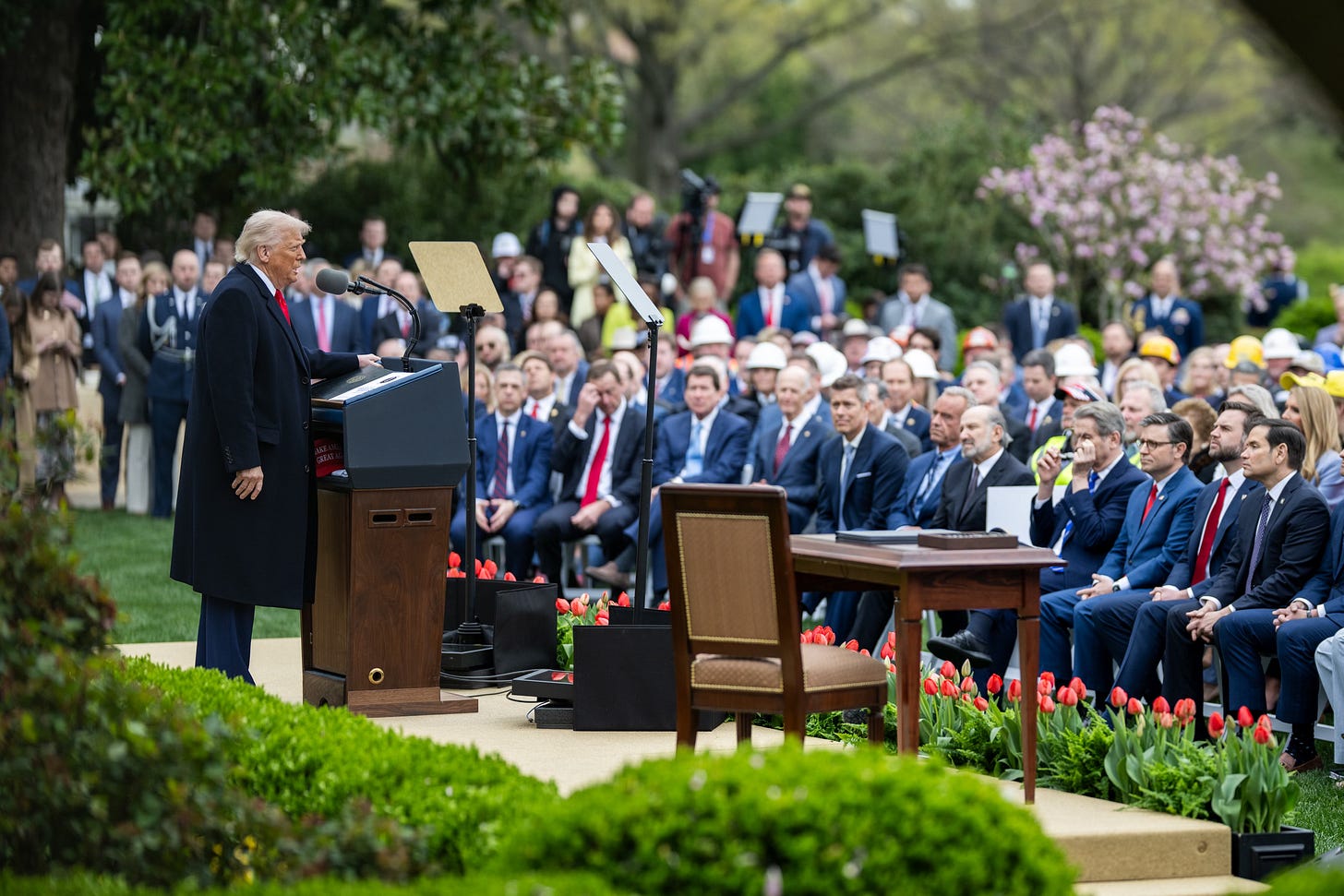Brexit and Trump’s Liberation Day could have worked. But not this way...
You can’t kill Godzilla with a slap. Thus, we’ve reached into the armory and taken out the tariff bazooka.
With Liberation Day underway, on Wednesday, Donald Trump finally launched his fusillade of tariffs, universally raising duties on imported goods. The levies are so universal in fact, that he is apparently even placing tariffs on uninhabited islands. His goal is simple: raise the drawbridge between foreign markets and the U.S. economy, give time for America’s manufacturing sector to reindustrialize, and then reopen the country to outside markets once it is far more competitive against the likes of China, South Korea and Vietnam.
His mentality is one of crisis, of the type Michael Anton (writing under the pseudonym Publius Decius Mus) described in his famous treatise “The Flight 93 Election,” which was published right before Trump won the 2016 election. “2016 is the Flight 93 election: charge the cockpit or you die,” he wrote of the crisis brewing in America. “You may die anyway. You—or the leader of your party—may make it into the cockpit and not know how to fly or land the plane. There are no guarantees.”
It’s become a Washington commonplace that American industry is dying (a rare consensus backed by ample evidence). The Biden administration worked to build a new industrial policy with the passages of the CHIPS and Science Act and the Inflation Reduction Act, and those were big tickets: the former $250 billion, the latter an initial several hundred billion with more aggressive estimates reaching trillions of dollars when considering future energy subsidies.
Even so, America’s trade deficit with China crossed a psychological threshold in 2024 when it surpassed $1 trillion, and there is little proof that any of these Biden-era policies stanched the bleeding. While TSMC, Samsung and others launched construction on new domestic fabs, China seems poised to build its own indigenous supply chain in chips anyway. Meanwhile, even America’s most advanced industries are facing immense competitive pressure. Domestic biotech and pharma leaders, for instance, are sounding the alarm that their entire industry could be lost to China by the end of the decade.
You can’t kill Godzilla with a slap. Thus, we’ve reached into the armory and taken out the tariff bazooka.
Economists, of course, universally hate tariffs because they ultimately shrink GDP — goods become more expensive and thus fewer trades are made. It’s rare for the dismal science to uniformly hate a policy, but that consensus is also a function of the limited lens economists use to evaluate societal health. GDP growth is correlative to well-being, but it’s not definitional. Both the distribution of that GDP and the composition of that GDP matter, something economists rarely debate.
What Trump and his team implied with yesterday’s announcement is that short-term economic pain at the grocery store and online are worth the long-term benefits of rebuilding American industry.
Unfortunately, we have seen much of this show before with Brexit. The goal was to “take back control” and allow Westminster and the British public the opportunity to radically improve their economic trajectory without the regulatory shackles of the European Union. In the nearly decade since the 2016 vote, the U.K. has suffered tremendously, with estimates of a loss of 4% GDP that by some measures, has made the average Briton poorer than America’s poorest state of Mississippi.
Why was Brexit a failure? For the same reason yesterday’s tariffs will be a failure: they aren’t backed up by a strategy to profoundly transform the economy.
Take a step back and imagine your goal is to improve American industry, making it more productive and competitive. That’s a massive shift in fundamentals. At the highest macroeconomic level, you’d have to mobilize workers from the services industries and draft them into manufacturing, while also redirecting the financial industry’s prodigious profits and reinvesting them into factories. This isn’t small-fry: we are talking about the shift of trillions of dollars.
If such a shift is the goal, there are many, many tools to accomplish it, and those tools can work well together. New factory tax credits, workforce development grants, financial transaction taxes, reform of K-12 and higher education, surcharges on services, zoning and construction permitting reforms, improvements to energy production and the grid … the list goes on and on. Change everything to make industry more attractive to investors, executives, workers and the markets. In fact, that comprehensive attack is exactly what countries like China and South Korea do: they set society-wide goals around the economy, and then bring to bear the full toolbox of policies available to turn those goals into reality. We’ve already seen their positive results.
Britain — to this day — has never offered a post-Brexit economic strategy and then implemented it via the treasury and throughout the country. Yesterday at his press conference announcing the tariffs, Trump pointed to charts showing a bunch of big percentages, but none of his new barriers were complemented by policies that would actually refocus business leaders on reindustrialization. “This moment too shall pass” is the correct response, as is everyone jumping into their brokerage accounts to sell off American companies today.
What could have been though? American industry is indeed in crisis, as I have written incessantly. Tariffs are a useful tool in that context — even at massive scale — despite what economists say. But they are useless without a comprehensive and thoughtful industrial strategy that forcibly skews the economy toward reinvestment in industry and away from services. It’s like solving today’s egg shortage by massively increasing chicken feed — sure, that helps, but having hens seems to be a necessary condition, too.
What we got yesterday was a Liberation Day with the parade but without the liberty. What a disaster that didn’t have to be.



